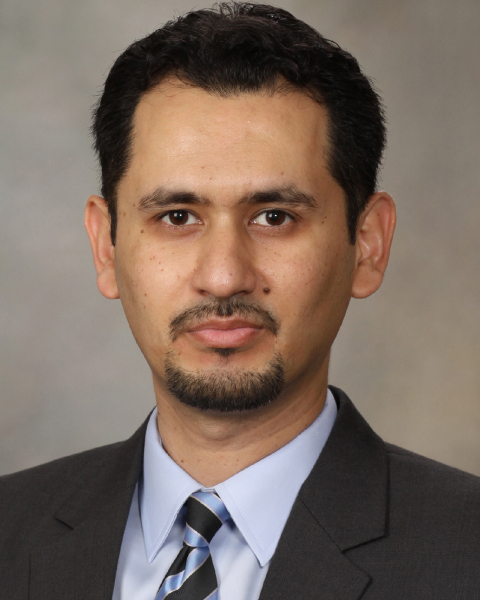SS 01 - Breast Cancer 1: Clinical Trials
104 - Conventional vs. Hypofractionated Proton Postmastectomy Radiotherapy: Patient Reported Outcomes from a Randomized Phase 2 Trial
Sunday, September 29, 2024
8:40 AM - 8:50 AM ET
Location: Room 202

Muhammad Shuja, MD
Mayo Clinic Rochester
Rochester, MN
Presenter(s)
M. Shuja1, M. Dorr2, B. Fruth3, R. K. Dhanoa1, N. Remmes1, J. C. Boughey4, C. Harless5, K. J. Ruddy6, L. A. McGee7, R. W. Gao1, D. Shumway1, T. Z. Vern-Gross7, S. S. Park1, K. S. Corbin1, C. E. Vargas7, and R. W. Mutter1; 1Department of Radiation Oncology, Mayo Clinic, Rochester, MN, 2Department of Quantitative Health Sciences and Alliance Statistics and Data Management Center, Mayo Clinic, Rochester, MN, 3Division of Biomedical Statistics and Informatics, Mayo Clinic, Rochester, MN, 4Department of Breast Surgery, Mayo Clinic, Rochester, MN, 5Department of Plastic Surgery, Mayo Clinic, Rochester, MN, 6Division of Medical Oncology, Mayo Clinic, Rochester, MN, 7Department of Radiation Oncology, Mayo Clinic, Phoenix, AZ
Purpose/Objective(s): Proton postmastectomy radiation therapy (PMRT) is under investigation and increasingly used in clinical practice. However, limited prospective health related quality of life data have been reported to assist patients and physicians with treatment decisions. To date studies involving proton PMRT have primarily used conventional fractionation (CF). We evaluated patient reported outcomes from a randomized trial comparing CF and hypofractionation (HF) proton PMRT, including those with immediate breast reconstruction. Materials/
Methods: We conducted a randomized phase 2 trial (MC1631) comparing CF (50 Gy in 25 fractions [relative biological effectiveness (RBE) 1.1]) and HF (40.05 Gy in 15 fractions [RBE 1.1]) proton PMRT. Patients were randomly assigned (1:1) to either CF or HF, with presence of immediate reconstruction (yes vs no) as a stratification factor. All patients were treated with pencil-beam scanning. Eligibility criteria included age 18 years or older with breast cancer resected by mastectomy with or without immediate reconstruction with indications for PMRT. Psychosocial well-being, physical well-being, sexual well-being, satisfaction with breasts, and satisfaction with outcomes scores were measured using the condition-specific validated BREAST-Q patient-reported outcome instrument during annual follow-up. Data were analyzed using linear mixed-effects modeling. This trial is registered with ClinicalTrials.gov, NCT02783690.
Results: 74 of 82 randomized patients (90%) completed at least one BREAST-Q questionnaire (36 CF, 38 HF). Median age was 53 years (range 32-78). 52 (70%) had immediate breast reconstruction with tissue expanders (83%), implants (13%), or autologous reconstruction (4%) at the time of PMRT. 57 (77%) received neoadjuvant and/or adjuvant chemotherapy. At 36 months, mean score (95% CI) of patient-reported satisfaction (mastectomy) was 59.5 (51.2-67.8) for CF and 61.0 (52.5-69.5) for HF. Amongst patients with reconstruction, similar satisfaction with breasts (63.9 [55.9-71.9] vs 59.0 [51.1-66.8]) and satisfaction with outcome (70.3 [60.0-80.7] vs 70.5 [60.0-81.0]) scores were observed for the CF and HF arms, respectively. No significant differences were also observed for psychosocial well-being, physical well-being, and sexual well-being.
Conclusion: CF and HF proton PMRT yield similar patient reported satisfaction and well-being at 3 years of follow up.
Purpose/Objective(s): Proton postmastectomy radiation therapy (PMRT) is under investigation and increasingly used in clinical practice. However, limited prospective health related quality of life data have been reported to assist patients and physicians with treatment decisions. To date studies involving proton PMRT have primarily used conventional fractionation (CF). We evaluated patient reported outcomes from a randomized trial comparing CF and hypofractionation (HF) proton PMRT, including those with immediate breast reconstruction. Materials/
Methods: We conducted a randomized phase 2 trial (MC1631) comparing CF (50 Gy in 25 fractions [relative biological effectiveness (RBE) 1.1]) and HF (40.05 Gy in 15 fractions [RBE 1.1]) proton PMRT. Patients were randomly assigned (1:1) to either CF or HF, with presence of immediate reconstruction (yes vs no) as a stratification factor. All patients were treated with pencil-beam scanning. Eligibility criteria included age 18 years or older with breast cancer resected by mastectomy with or without immediate reconstruction with indications for PMRT. Psychosocial well-being, physical well-being, sexual well-being, satisfaction with breasts, and satisfaction with outcomes scores were measured using the condition-specific validated BREAST-Q patient-reported outcome instrument during annual follow-up. Data were analyzed using linear mixed-effects modeling. This trial is registered with ClinicalTrials.gov, NCT02783690.
Results: 74 of 82 randomized patients (90%) completed at least one BREAST-Q questionnaire (36 CF, 38 HF). Median age was 53 years (range 32-78). 52 (70%) had immediate breast reconstruction with tissue expanders (83%), implants (13%), or autologous reconstruction (4%) at the time of PMRT. 57 (77%) received neoadjuvant and/or adjuvant chemotherapy. At 36 months, mean score (95% CI) of patient-reported satisfaction (mastectomy) was 59.5 (51.2-67.8) for CF and 61.0 (52.5-69.5) for HF. Amongst patients with reconstruction, similar satisfaction with breasts (63.9 [55.9-71.9] vs 59.0 [51.1-66.8]) and satisfaction with outcome (70.3 [60.0-80.7] vs 70.5 [60.0-81.0]) scores were observed for the CF and HF arms, respectively. No significant differences were also observed for psychosocial well-being, physical well-being, and sexual well-being.
Conclusion: CF and HF proton PMRT yield similar patient reported satisfaction and well-being at 3 years of follow up.
